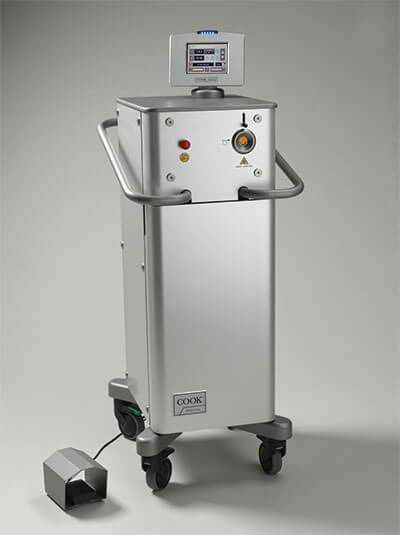The Rhapsody® H-30® Holmium Laser System features a variable pulse width, which enables a physician to tailor their treatment on the fly. This ability to adjust settings and tailor treatment has led to discussions on stone lasing techniques as well as power needs.
How much power do you need?
“Commercially available laser systems can be grouped into two broad categories: low-power (typically offering 10–30 W) and high-power (offering 60–100 W). The low-power lasers are generally less expensive and offer easier portability due to their smaller size, but generally have less flexibility in terms of pulse energy and are unable to provide more than 25 Hz in pulse frequency. In contrast, the high-power lasers tend to be more expensive and bulky but are able to deliver greater options for pulse energy and frequency settings.”1
The exact settings used to dust or bust a stone will vary depending on the specific laser. Typically, high-powered lasers use high energy (joules) and low frequency (hertz) to bust, and they use the opposite settings to dust.
 With just 30 watts, you can dust or bust with the Rhapsody H-30 laser system by adjusting the variable pulse width. In an in vitro study, the Rhapsody H-30 laser system “demonstrated similar stone treatment efficiency” to that of a high-power (120 W) system (at similar settings).2
With just 30 watts, you can dust or bust with the Rhapsody H-30 laser system by adjusting the variable pulse width. In an in vitro study, the Rhapsody H-30 laser system “demonstrated similar stone treatment efficiency” to that of a high-power (120 W) system (at similar settings).2
“Treatment times using the [120 W] and the [Rhapsody] H-30 lasers were equivalent. Retropulsion distances were less with both lasers when longer pulse widths were used. The [Rhapsody] H-30 resulted in less stone retropulsion compared with the [120 W]. … In a head-to-head comparison using the long pulse setting, there was twice the retropulsion distance using the [120 W] laser vs the [Rhapsody] H-30 laser (13.9 cm vs 7 cm, respectively). There was an even greater difference in retropulsion distance with the [120 W] laser vs the [Rhapsody] H-30 laser on short pulse setting (56.6 cm vs 14.5 cm).”2
Meet the Rhapsody H-30
The Rhapsody H-30 laser system features a variable pulse width that minimizes stone migration3-6 and maximizes tissue coagulation.7 The short pulse width is recommended for breaking apart dense or large stones for basketing. The long pulse width is appropriate for dusting. The long pulse width has the additional benefit of reducing retropulsion, or stone migration.3,4
- The 30 W treatment power allows you to treat stones and soft tissue.
- A green aiming beam provides contrast and visualization of the surgical site.
- The user-friendly touchscreen controls allow you to quickly change parameters during procedures.
Long pulse width benefits
- May reduce retropulsion, or stone migration3-6
- May allow more energy delivery before stone retropulsion and fiber repositioning with continuous pulses5
- May reduce laser fiber tip degradation6
Service and maintenance
A premium service agreement can be purchased for your laser system to provide preventive maintenance and cover service or repairs should the need arise. Talk to a Cook Medical capital equipment specialist for more information.
- Patel AP, Knudsen BE. Optimizing use of the holmium:YAG laser for surgical management of urinary lithiasis. Curr Urol Rep. 2014;15(4):397.
- Bell JR, Penniston KL, Nakada SY. In vitro comparison of stone fragmentation when using various settings with modern variable pulse holmium lasers. J Endourol. 2017;31(10):1067-1072.
- Kang HW, Lee H, Teichman JM, et al. Dependence of calculus retropulsion on pulse duration during Ho:YAG laser lithotripsy. Lasers Surg Med. 2006;38(8):762-772.
- Finley DS, Petersen J, Abdelshehid C, et al. Effect of holmium:YAG laser pulse width on lithotripsy retropulsion in vitro. J Endourol. 2005;19(8):1041-1044.
- Kalra P, Le NB, Bagley D. Effect of pulse width on object movement in vitro using holmium:YAG laser. J Endourol. 2007;21(2):228-231.
- Wollin DA, Ackerman A, Yang C, et al. Variable pulse duration from a new holmium:YAG laser: the effect on stone comminution, fiber tip degradation, and retropulsion in a dusting model. Urology. 2017;103:47-51.
- Bagley DH, Grasso M 3rd. Ureteroscopic laser treatment of upper urinary tract neoplasms. World J Urol. 2010;28(2):143-149.